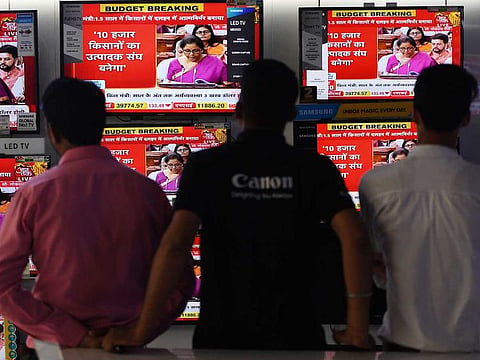India budget 2019-2020 scores high on clarity, lacks the big boost
Government spending plan fails to impress markets

Also In This Package
Dubai: India’s full year budget for fiscal year 2019-2020, that came after the government tabled the Economic Survey, which targeted a 7 per cent GDP growth for the current year and emphasised on employment creation, has come with hardly any big proposals to boost both economic growth and job creation, two big challenges India is facing currently.
The budget scored high on clarity in terms of proposals relating structural reforms and policy direction and some of the policy actions to be taken to bring about drastic changes to improve economic growth.
In her first budget speech to Parliament in New Delhi, Finance Minister Nirmala Sitharaman said the government will consider further opening up foreign direct investment (FDI) in aviation, while easing local sourcing norms for single-brand retail companies. It is the right time for India to enter into aircraft financing, Sitharaman said. The government will also adopt suitable policy interventions for providing an enabling ecosystem for maintenance, repair, and overhaul of aircraft.
While proposals such as no income tax up to a personal income of Rs 500,000 is widely welcomed, a new surcharge of additional Rs1 per litre on petrol and diesel are sure to have adverse impact on inflation and disposable income of the middle class.
The Economic Survey had placed a great deal of emphasis on kick starting economic growth which had taken a beating during the last two years, but the budget proposals seemed more focused on long term structural changes without immediate action plans.
Clearly, equity markets were not impressed by the budget speech. At some point towards the end of the budget presentation, key equity index Sensex fell over 400 points to 39, 441, while Nifty50 fell 113 points to 11,833 level. Currently public sector bank is the sole gaining sector. After the strong bullish push early morning, ahead of the budget, Indian equity market indices are trading flat with negative bias, as market participants turn cautious with the outcome of Union Budget 2019.
$5 trillion promise
Finance minister said the Indian economy will grow to $3 trillion in the current fiscal year. She said it is now the sixth largest in the world as compared to the 11th position five years ago and the economy has the capacity to reach $5 trillion in the next few years.
While the ambitious target has been detailed, the minister did not spell out clear as to how the government plans to finance its expenditures to achieve that target. On the revenue side of the budget, in addition to enhancing tax collection, government seems to be dependent on disinvestment of public sector undertakings including Air India. The target for disinvestment from central government-owned enterprises has been raised from Rs900 billion last year to Rs1.005 trillion in the current fiscal year.
Clarity in taxation
More clarity in terms of corporate and personal income taxes have brought cheers to middle income groups. Phased reduction of taxes will continue. Companies with an annual turnover of up to Rs4 billion will now be eligible for the lower 25 per cent corporate tax. The earlier limit was Rs2 billion. Around 99.3 per cent of Indian companies will now come under the lower tax limit.
Budget clearly score high on policy simplification, starting with tax rates and filing of tax returns. The Minister proposed a series of measures to leverage technology and make compliance easier for taxpayer. Interchangeability of PAN and Aadhar will come handy to many as PAN card is no longer mandatory to file income tax returns. In addition, pre-filled tax returns will be now available for taxpayers from the Income Tax department with details of tax deductions, bank deposits, information collected from various sources.
Sign up for the Daily Briefing
Get the latest news and updates straight to your inbox




